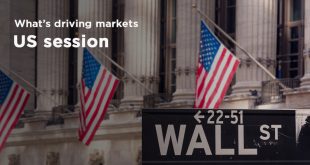Minutes of the United States Federal Reserve’s April meeting showed that a number of monetary policy makers are beginning to contemplate the idea of changing the current easing policies, amid signs of economic recovery.
“A number of participants suggested that if the economy continued to make rapid progress” toward the Federal Open Market Committee’s goals, “it might be appropriate at some point in upcoming meetings to begin discussing a plan for adjusting the pace of asset purchases.”
Fed officials plan to maintain the easing policies, expecting the recent surge in consumer prices to be temporary, with the inflation rate yet to reach the 2% target on a sustainable basis. This view was reflected by the recent remarks of a number of fed officials.
Substantial further growth in reaching full employment, by restoring the pre-pandemic unemployment levels, and the price stability target with the inflation rate sustainably reaching 2%, would likely need some time, according to the participants.
“Various participants commented on the prolonged period of low interest rates and highly accommodative financial market conditions and the possibility for these conditions to lead to reach-for-yield behavior that could raise financial stability risks.”
FOMC members, who voted unanimously to leave interest rates unchanged, also pointed to the positive effects of the historically low rates on the housing market activity.
Participants in the meeting continued to focus on progress toward economic reopening, as well as the supportive monetary and fiscal policies, the minutes showed.
Meanwhile, it also pointed to the rise in equity prices, with the S&P 500 index reaching a new record high, while Treasury bond yields, the U.S. Dollar (USD), and credit spreads showing a modest decline.
The minutes specifically pointed to the recent retreat in Treasury yields, following some surged that raised questions marks about moving interest rates.
“Regarding expectations for the policy outlook, the market- and survey-implied paths of the federal funds rate were both relatively little changed over the intermeeting period, and the modal survey path in later years continued to imply that the target range would gradually increase to a level just over 2 percent in 2026.”
As for the expectations for the path of asset purchases, the minuted showed that they were also stable, and “market participants remained focused on the Committee’s communications about progress toward its goals.”
“According to the median survey responses, the Federal Reserve’s net purchases of Treasury and agency securities were expected to end three quarters after the first reduction in the pace of asset purchases, and the first increase in the target range for the federal funds rate was expected to occur three quarters after that.”
Furthermore, the minutes said that the FOMC is partially basing its expectations for the economy on the state of the COVID-19 pandemic, with the measures undertaken to contain its spread continuing to affect economic activity in the United States and abroad.
Despite the expansion of the gross domestic product (GDP) in the first quarter of the year, it is yet to fully return to its pre-pandemic level, just like employment.
“In the first quarter of 2021, the staff’s common inflation expectations index, which combines information from many indicators of inflation expectations and inflation compensation, had returned to the level that prevailed in 2018.”
The minutes further pointed to the uncertainty surrounding expectations for economic recovery, amid the risks created by the pandemic.
“In their discussion of the household sector, participants remarked that indicators of consumer spending surged in March and expected that further gains in spending would contribute significantly to the economic recovery. Many participants commented that fiscal stimulus, accommodative financial conditions, the release of pentup demand, progress on widespread vaccination, and the ongoing reduction of social distancing.”
As for inflation, the FOMC members it would move above 2% in the near term, as very low readings from early in the pandemic fall out of the calculation. In addition, increases in oil prices were expected to pass through to consumer energy prices, as well as the expected surge in local demand.
They believe the inflation rate will temporarily run above 2%.
“After the transitory effects of these factors fade, participants generally expected measured inflation to ease.”
It is worth noting that recent remarks by the Fed officials suggested that before the central bank considers changing interest rates, it will likely begin by scaling back its massive asset purchases or the bond-buying program, a move that Powell will warn the market about ahead of the decision to avoid any shocks to the debt market, which we now know might be discussed in the upcoming FOMC meetings.
 Noor Trends News, Technical Analysis, Educational Tools and Recommendations
Noor Trends News, Technical Analysis, Educational Tools and Recommendations





